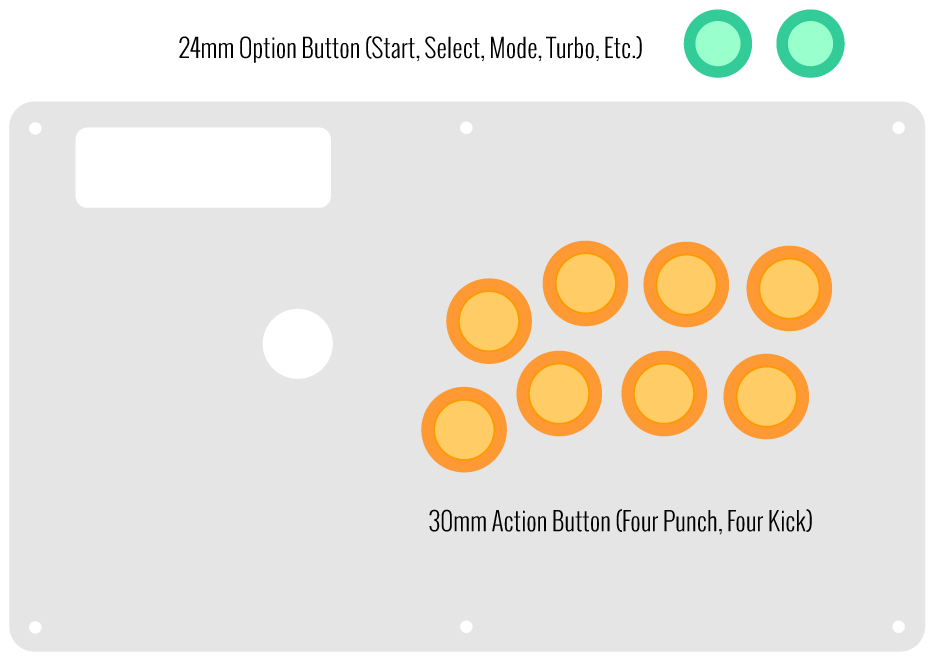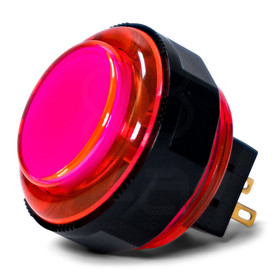- Category
- What's New?
- FightSticks/Pads
- Joysticks
- Pushbuttons
- Spare Parts & Tools
- Hardware & PCB
- Electrical
- Customize
- Merchandise
- Sales & Clearance
- Brand
Seimitsu PS-14-KN 30mm Screw Button: Clear
-
Product Description
Important: New Screwbutton Ring Design
 This pushbutton comes with a new screwbutton ring. Seimitsu is replacing its original clear or milky white screwbutton ring with a black plastic alternative. For 30mm, this ring is thinner than the original model, more compact for tight spaces, and easier to screw on or off. For 24mm, the screw ring resembles the original model except in black. Some of our current photos may reflect the older screw ring. Due to the amount of photos needed to replace them, we are temporarily adding a note until new photos can be taken.
This pushbutton comes with a new screwbutton ring. Seimitsu is replacing its original clear or milky white screwbutton ring with a black plastic alternative. For 30mm, this ring is thinner than the original model, more compact for tight spaces, and easier to screw on or off. For 24mm, the screw ring resembles the original model except in black. Some of our current photos may reflect the older screw ring. Due to the amount of photos needed to replace them, we are temporarily adding a note until new photos can be taken.
The Seimitsu PS-14-KN arcade pushbutton is only second in popularity to the SANWA series. Available in several translucent colors, artwork can also be inserted under the cap of the plunger. and are sought after for their increased customization ability with joystick graphics and LED mods. Seimitsu buttons offer the same high-quality and responsiveness as a Sanwa, but a slightly different feel and sound.
Each comes with a screw nut, making it an excellent choice for both metal and wood joysticks. The buttons are compatible with MadCatz FightSticks, Qanba and Hori joysticks. The PS-14 KN uses the Seimitsu PS-14-G Button Micro Switch.
Black Screw Ring
The latest iteration of the Seimitsu screwbutton models now possess a black screw ring that is taller, more compact and easier to screw on. This helps the button navigate tighter spaces of some layouts. Additionally, the screw ring design more easily displays the proper orientation to screw in via small bumps at the top, which also help to grip the ring to a metal or wooden chassis.
Bundle with MM9-4 High Tension Button Spring and Save
By default, Seimitsu PS-14-G microswitch requires 1.0N or 0.2 LBF (pounds force) to each button.
The MM9-4-25N adds an extra .08 LBF (pounds force), for a total of 0.28 LBF. The result is a light, but firm button input requirement that accelerates its the button cap's return to neutral.
The MM9-4-50N adds an extra .16 LBF (pounds force), for a total of 0.34 LBF, resulting in a much firmer button input requirement that quickly pushes the button cap's to neutral position, ready for the next press.
This is desirable to some who appreciate using more deliberate input force and a bit less sensitivity than Sanwa's SW-68 offers. Now, you can save 25 cents off the regular price of the MM9-4 series spring when you choose one of the high tension springs from the options list.
Bundle with Silencer 30mm Foam Washers




Silencer is our 1mm-thick foam washer that helps to dampen the loud sounds common with tapping on the button plunger. It conforms to the internal housing of many Sanwa or Seimitsu-style 30mm pushbuttons.
Known compatibility:
Sanwa Seimitsu Crown Hori Silencer Installation
installing the Silencer foam pads into a Sanwa or Seimitsu pushbutton is straightforward. Place the washer - plastic film side down - into the button housing. Align the small tabs so that they stick out of the holes on each side of the housing. For Seimitsu PS-15, and Hori Hayabusa low profile pushbuttons, snip the tabs off with scissors and place into the housing.
24 vs 30mm When processing orders, a frequent mistake we found among new players is choosing the wrong size for action buttons, such as punch and kick.
Within the fighting game genre, Japanese arcade buttons commonly consist of two diameter sizes: 24 millimeter and 30 milllimeter (mm). In most configurations, 30mm represents your action button. These are front facing, appearing most prominent on your Fightstick control panel. Option button, such as "Start", "Select", or more recently "Option", "Touch", or "Share" are usually 24mm.
UPDATE: Owners of Neo Geo AES Joysticks will need 24mm pushbuttons instead of 30mm (Thanks SRK's DEZALB)
Below is a visual representation of a common Fightstick control panel. Throughout this article, we will mark 24mm in green, and 30mm in Orange.

Checking the Proper Size
 Another way that players can misinterpret the pushbutton size is by measuring the pushbutton plunger. Have a look at the diagram at right.
Another way that players can misinterpret the pushbutton size is by measuring the pushbutton plunger. Have a look at the diagram at right.The plunger - the part that you press down to represent an input - is 25mm or a bit smaller in most 30mm pushbuttons. Often this leads to the conclusion that one needs a 24mm button and not 30mm.
Similarly measuring the button rim can lead to confusion, as it is intentionally larger than the button hole it is placed in. You don't want to use these measurements. Instead, review the button housing diameter, or the hole the button will be placed in. You can do this with a caliper - a digital caliper is often quite helpful for this and other arcade-related projects.
Control Panel Configuration
Most Fightsticks from MadCatz, Hori, Qanba, and similar will use these two sizes. How the buttons are used will depend on the model joystick that you own. Over time, we'll provide example configurations for specific popular Fightstick models and arcade cabinets using the color key for 24mm (green) and 30mm (orange). We'll also expand the key for future models if another size is introduced, and we offer for sale.




-
Product Reviews
-
Quality Japanese parts. Can't go wrong.
Great buttons that are the alternative to Sanwa. It requires a bit more force to get the buttons to register versus the spongy feel of Sanwa. Great for those who like to hover over their buttons and not have to accidentally press. Also the screw in buttons are in my opinion will never have problems such of panels being too thick and the arms breaking from the tension. Rayne on Jul 2nd 2019
-
Good but not for the HRAP4
The buttons are very good but a set of 8 will not fit in the HRAP4 due to the bottom far right button not having enough room to fit the screw piece. So if you can get seven and one snap in button then that works. Very good for 6 button layouts though. Unknown on Mar 27th 2017
-
Best buttons out
They aren't as sensitive as as the stock buttons which are good, I needed them for sfv and they work great really good with precision. Datwan L. Smith on Jul 19th 2016
-
Great quality, responsive tactile feel
Seems like there's not too much information about these buttons or Seimitsu buttons in general. The big standard right now is Sanwa and most fight sticks that ship, come stock with Sanwa buttons.
I bought these buttons mostly out of curiosity. I see a lot of people on forums that prefer Seimitsu because of the higher pressure required to activate them. First of all I'd like to say that the buttons feel just as nice and premium as Sanwas. Compared to obsc and obsf buttons these require just a tad bit more pressure that is noticeable but not game changing. I didn't have any difficulty getting used to these and I have to say that the sturdier feel is nice. They do have a bit of a tactile bump as opposed to sanwas which are more of a straight down straight up feel. One thing I love about these Seimitsu is the screw on style. Sanwas obsc and most buttons in general have 2 clips which I have trouble keeping intact when removing them. They actually break quite often. Sanwa does also offer screw buttons but for some reason Seimitsu is the only one at the moment that makes screw in clear buttons.
All in all if you're looking for an alternative to sanwa with a bit more resistance I definitely recommend these Mando on Oct 7th 2015
-
-
Find Similar Products by Category









